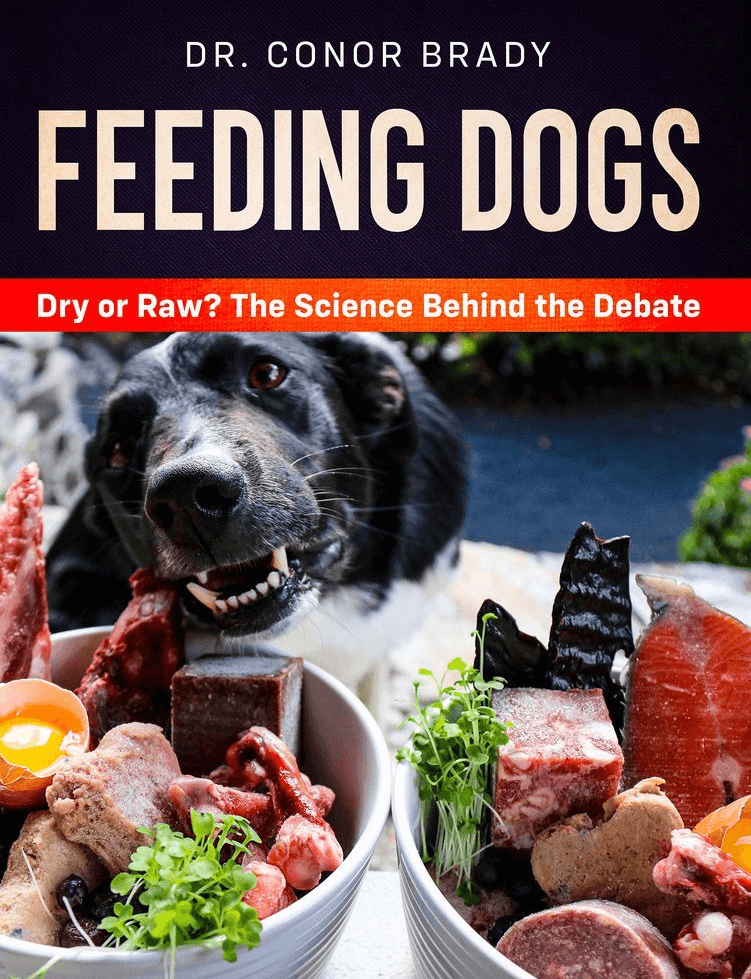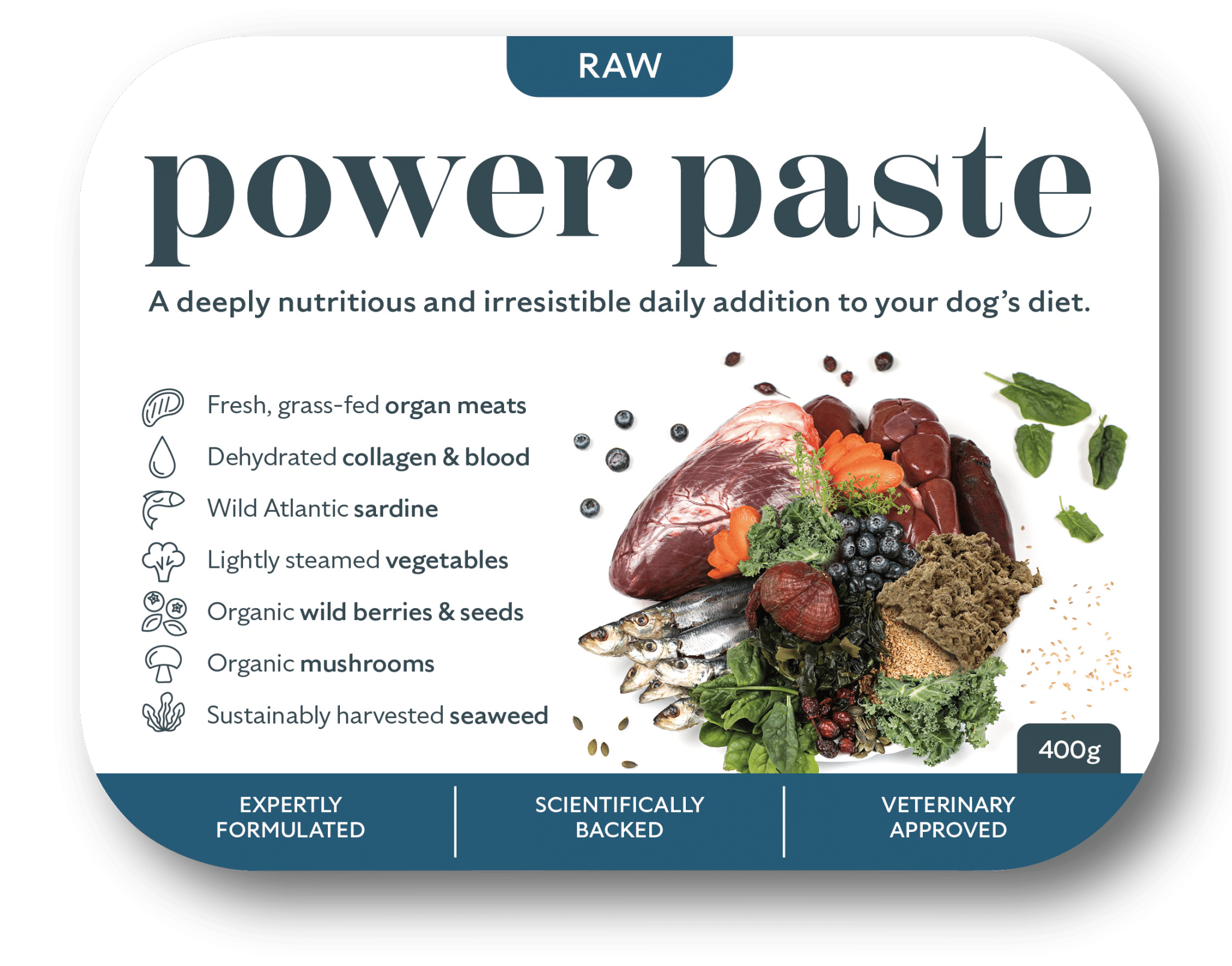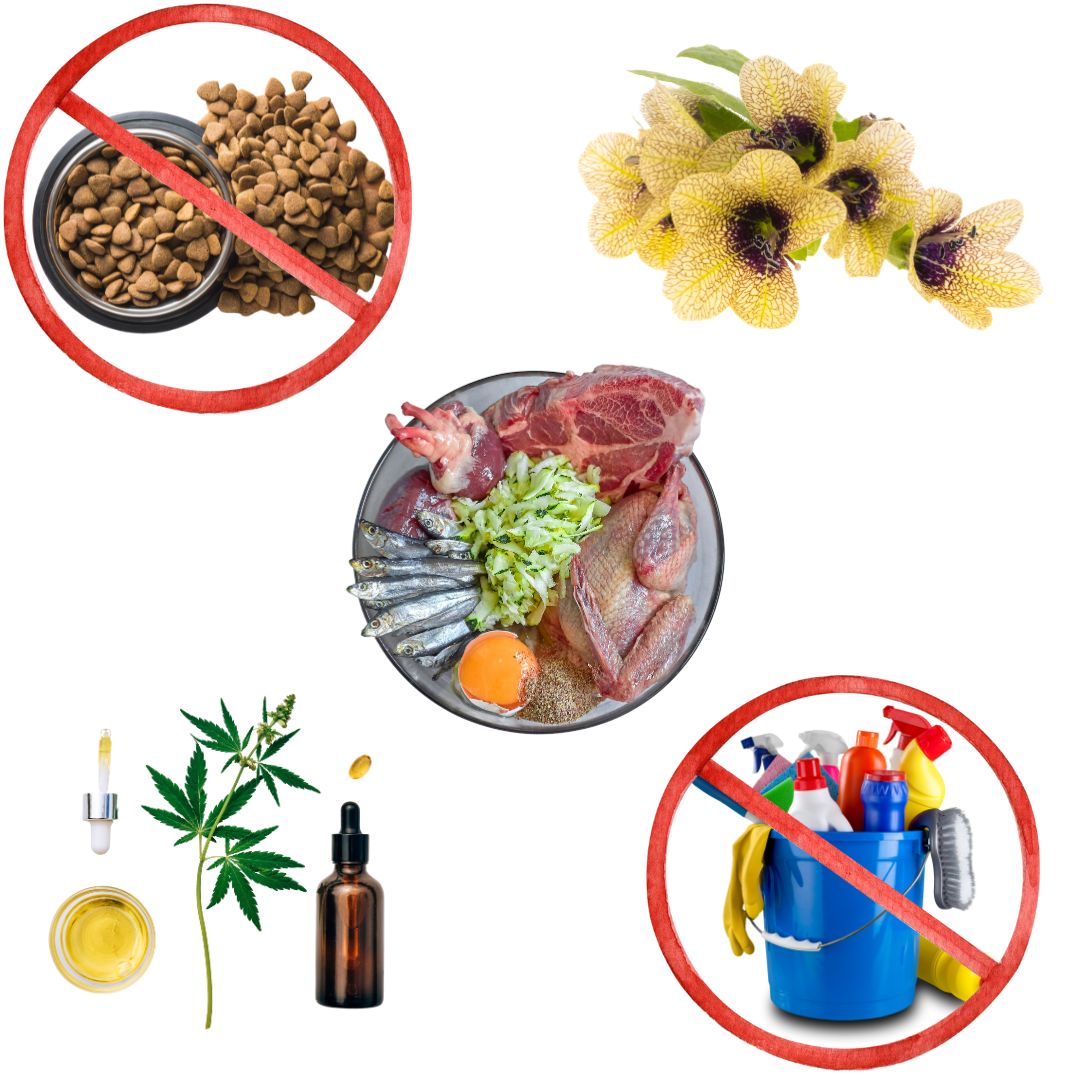A comprehensive review of the pros and cons of feeding dogs vegetables, and best advice…
Of all the ingredients we can put in their bowl, none create more debate than the mention of feeding vegetables to dogs. A quick trip around the forums reveals a lot of cliques. From the prey model to the lots-of-fruit-and-veggies groups (the latter need a snazzier name) and everyone in between, there are a lot of opinions out there. This is to be expected. As we shake off the pseudoscience of the processed food sector, we emerge, blinking, into a vast field of science where we now know surprisingly little. Isn’t that crazy? Our oldest and most revered non-human companion and we barely know what he needs to eat.
During their research, some folk out there seem to get to a certain level of canine nutritive knowledge and then draw a mental line and say “that’s it for me, I have what I need, no more studying or testing”. They may then bed in with surprising stubbornness, tragically replicating what vets were doing to them for years when the notion of feeding pets was first suggested to them across the examing table.
If you talk to anyone at the top of this wonderful field of science, you get what you always get in any other realm of science – a whole lot of uncertainty. People outside the science sphere might find that unusual, you would think with all the study they would know exactly what’s going on but science rarely grants the practitioner such solace. The irony is the more you know the more you realise you don’t know, no matter how specialised you get. You never stop learning. So here’s what we do and don’t know about feeding vegetables to dogs.

The dog is a meat eater, we all accept that…
Most canine nutritionists agree the dog is, to a very large extent, a meat, organ and bone eater. An adaptabe, opportunistic, scavenging predator. A whole-animal eater. A carcass-finding machine. A long-distance-hunting machine. Our article on why dogs need meat goes through all the evidence that supports this stance:
- From tooth to tail, the dog has the anatomy of a meat eater, with jagged teeth, short, fast, acidic guts, bacterial flora ill-equipped to break down plant fibre breakdown
- Studies of their closest relatives (dingo’s, which were domestic dogs only 3,000 years ago) reveals a diet comprising of 97% animal matter
- Stuides show dogs will eat literally anything with a face, from small mammals to birds to frogs to insects to carcass and faeces, though they are no longer able to bring down large quarry
- There is confusion in the diet studies as village dogs are fed plant material as pups and these dogs will go on to select plant material when older, however feral dogs do not. We have know for years that dogs can be targetted on to various proteins from a young age, it says nothing of it’s suitabilty to long term health.
But to suggest they have zero omnivorous traits is incorrect
We’ve known for some time that dogs and cats have the ability enzymatically (maltase, sucrose, and lactase) to digest carbohydrates (Hore and Messer 1968). Furthermore, it appears that dogs, unlike cats, have taken some further tiny steps towards plant carbohydrate (or back towards plant carbohydrate digestion, if you want to be particular, seeing as we were all plant eaters at one point and are still fatally linked to the products produced only by them, whether we consume them directly or eat the flesh of animals that eat them).
Axelsson et al. (2013) found that dogs have 32 more copies of a gene that is crucial for amylase production compared to wolves. The gene is 7-12 times more active in the pancreas of dry-fed dogs than in wolves. While we know that this tiny evolutionary step (in the last few thousand years) has not yet affected their diet choice (dingo-hybrid study above) or digestive anatomy to any noticeable degree, the findings are interesting but the dog’s overall diet choice remains clear.
Nor is this the only little omnivorous pointers we can see in the dog’s metabolism. Authors note that dogs appear to be able to convert carotene (derived from plant material such as carrots) to vitamin A, though they are extremely poor at it (NRC 2006). They can also convert some tryptophan (an amino acid) to niacin (vitamin B3), cysteine (an amino acid) to taurine (another amino acid) and linoleate (a salt form of linoleic acid) to arachidonate (polyunsaturated omega-6 fatty acid).

While we are today unsure whether many wolves have this ability to produce some vitamins and proteins from more readily available material, it’s theorised that these few processes may be required of a more scavenging lifestyle. But in a body conducting literally tens of thousands of carnivorous processes each minute, it’s sad to see that such little quirks are eagerly seized upon by the industry who point to these tiny little steps as examples why they make products that are ultra high in plant carbohydrate and plant protein and ultra lot in meat. The wonderful Jean Dodds (2015) gives her friend Doug Knueven’s example to explain how wrong this thinking is;
to say that because dogs can digest some starch better than a wolf proves that they thrive on a high starch diet long term is like asserting that because people can process ethanol and glucose we should thrive on a diet rich in rum and cookies!
Studies show dogs can digest plant material when it is presented correctly to them…
While the ideal amount of vegetable matter will likely never be known, there is certainty on a number of points. If carbohydrates are presented correctly to dogs (e.g. if they are dextrinised, cooked up, fibre removed) they can digest up to 84% of the carbs being fed to them (Rosmos et al. 1981). It’s the same with plant protein albeit with lower digestive coefficients. By simply measuring protein in and protein out, studies show dogs can utilise 30-40% of various protein flours including peanut, soybean and even some gluten (Mabee and Morgan 1951, Neirnick et al. 2001), compared to 75-90% of various meat proteins (Faber et al. 2009). The remaining circa 60% that they cannot digest will assumedly pass out safely as waste, bulking the stool.
While plant protein does not contain all of the dog’s essential amino acids as meat does, it does contain some and therefore, if it is digested, absorbed and assumedly metabolised, the dog absolutely is expected to benefit from their consumption.
As they are so mechanically poor at plant fibre digestion, it is by removing plant fibre from the equation via a light cooking or pulverising their veggie options, that we allow them access to the goodies inside. This has been firmly established by the dry food companies over the last century who have been producing products that comprise very largely of plant material (50-60% plant carbohydrates, perhaps 10% cheap plant protein additions such as corn gluten and 5-10% indigestible plant fibre), and dogs seem to be eking out existences on it (with the occasional veterinary intervention for chronic diseases that will pop up from such an outrageously inappropriate diet).
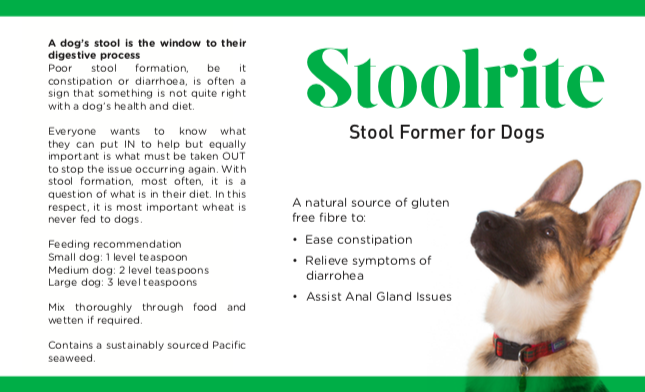
In fact, and you’re probably not going to like this, Wakefield et al. (2006) compared the long-term health of a population of 34 cats maintained on vegetarian diets (most, in fact, were vegan) to 52 on conventional, dry cat diets. The study lasted one year. No significant differences existed between the two groups in age, sex, body condition, housing, or perceived health status. Even their taurine levels were similar. And this is has been done a few times. The truth is, the only difference between these vegetarian diets and the usual, dry diets for cats is a token meat-meal addition and meat-meal is bottom of the barrel nutrition for a carnivore. It’s possibly so awful it might be they’re no worse off when it’s not in there. The difference between these two diets, in my opinion, would be the difference between hair and fur.
7 reasons why you might feed some plant material to your dog…
Thus, somewhere between zero plant matter and horrible amounts likely lies the truth. For what it’s worth I have always recommended a diet of 10-20% vegetable matter and this figure is loosely echoed by my peers (Dodds, Thompson, Browne, Lonsdale, Billinghurst, Pitcairn, Habib etc. It’s in fact, hard to find a canine nutritionist at the top of their game that is recommending the opposite, prey-model only with no veg). We have been using vegetable ingredients such as carrots, broccoli, leafy greens, sweet potato, pumpkin and oats, and fruit additions such as dark berries and many others, for many years to no visible or documented side effects. In fact, only the opposite seems to occur.
1. Protein, vitamins and minerals...
Plant ingredients clearly pack a nutritive punch. We know this from our own diet. Unable to produce many vitamins and all inorganic minerals ourselves, we gain vast amounts of our vitamins and minerals from plants (and bacteria that live on plant matter in our guts). When presented correctly (cooked / pulverised), dogs too can benefit from them. While a well-varied meat, organ and bone diet many contain enough, it’s a fact that many plant ingredients are positively crammed with vitamins and minerals to which no meat can compare. Furthermore, prey model feeders are underestimating just how poor some farmed meats may now be, nutritionally speaking. Poor farming practices with poor, unnatural food substrates and soil erosion is producing a very different meat quality to what the dog evolved upon.

An extra dose of vitamin B complex for focus in dogs, or of vitamin C in a time of need, as you would us, might make all the difference to a struggling dog. Steve Brown and Karen Becker did a nice raw dog food meal comparison where they formulate a standard enough beef and bone-in chicken recipes with and without vegetables and show the nutrient differences. The one with vegetables clearly brings up some of the nutrient contents from dangerously low to fantastic, such as vitamin K, manganese, magnesium and folic acid though they fail to tell us exactly what ingredients they used in the standard non-veg formulation.
2. Studies show there are major health benefits to be had...
To shun plant ingredients is to shun the science that proves their phytochemicals offer enormous benefit to us and dogs. These are the alkaloids (Known to improve heart function, cough suppressants, insect repellant, codeine is one!) terpenoids (there are more than 40,000 of these, found to prevent metabolic disorders, fight cancer, exert anti-aging benefits etc), polysaccharides (such as inulin, lignan and pectin, gut flora love them and they produce a nice poo) as well as the unbelievably antioxidant phenolic compounds such as flavanols (blood vessel function), anthocyanins (the colourful fruit and veggies, which improve immune, heart and cognitive function and fight cancer) and curcuminoids (turmeric, we surely all know about this bad boy by now?!).
But as dogs respond in the same way to the vast majority of these chemicals in the same way we do (hence we test all our foods and chemicals on them first), these amazing compounds can be of great benefit to dogs too and in the very same way. A remarkable study in Scotties fed either leafy green and yellow-orange vegetables (carrots and squash) at least three times a week were 70% – 90% less likely to develop bladder cancer than their cohorts who were not fed vegetables. You heard that correctly. 70-90%. Dunlap et al. (2006) boosted antioxidant levels in sled dogs by supplementing their diet with blueberries, thereby preventing exercise-induced oxidative damage in their dogs, undoubtedly increasing performance and recovery times, though this is yet to be measured.
My favourite study that shows the power of veggies in dogs in as follows, if just for what they did with the info. The study, entitled “Learning ability in aged beagle dogs is preserved by behavioural enrichment and dietary fortification: a two-year longitudinal study” (Milgram et al. 2005), was a fascinating two-year analysis of 65 beagles, 48 of whom were middle-aged and older. The study aimed to preserve cognitive abilities in ageing dogs using behavioural enrichment and diet supplementation. Two groups of dogs were fed “identical diets” as a baseline (a complete Hill’s Pet Food) though the test group diet was supplemented with a variety a mix of ingredients including spinach flakes, tomato pomace, carrot granules, citrus pulp and grape pomace (and vitamin C&E), all plant ingredients that contain phytonutrients that have long been linked to improved cognitive function in humans. After two years they were given black and white discrimination tasks. They found that the dietary fortification worked to preserve cognitive ability in the test dogs. In small writing the authors since declared this food was then taken to market, sold as Hill’s B/D, for the ageing dog, under “prescription”. You could spend all that money on that orrrrr you could add a little spinach, tomato pomace, carrot granules and citrus pulp to your ageing dogs’ diet. They don’t tell you that though, seems to be best that Hill’s do it for you, in a highly processed, grossly overpriced manner!
There are so many reasons you might add seaweed to their diet. Not only does seaweed offer a nice vitamin / mineral punch and some much-needed iodine, but they pack a great range of benefits that land plants do not. For example, check out how many studies I found that prove seaweed is a highly effective cancer fighter.
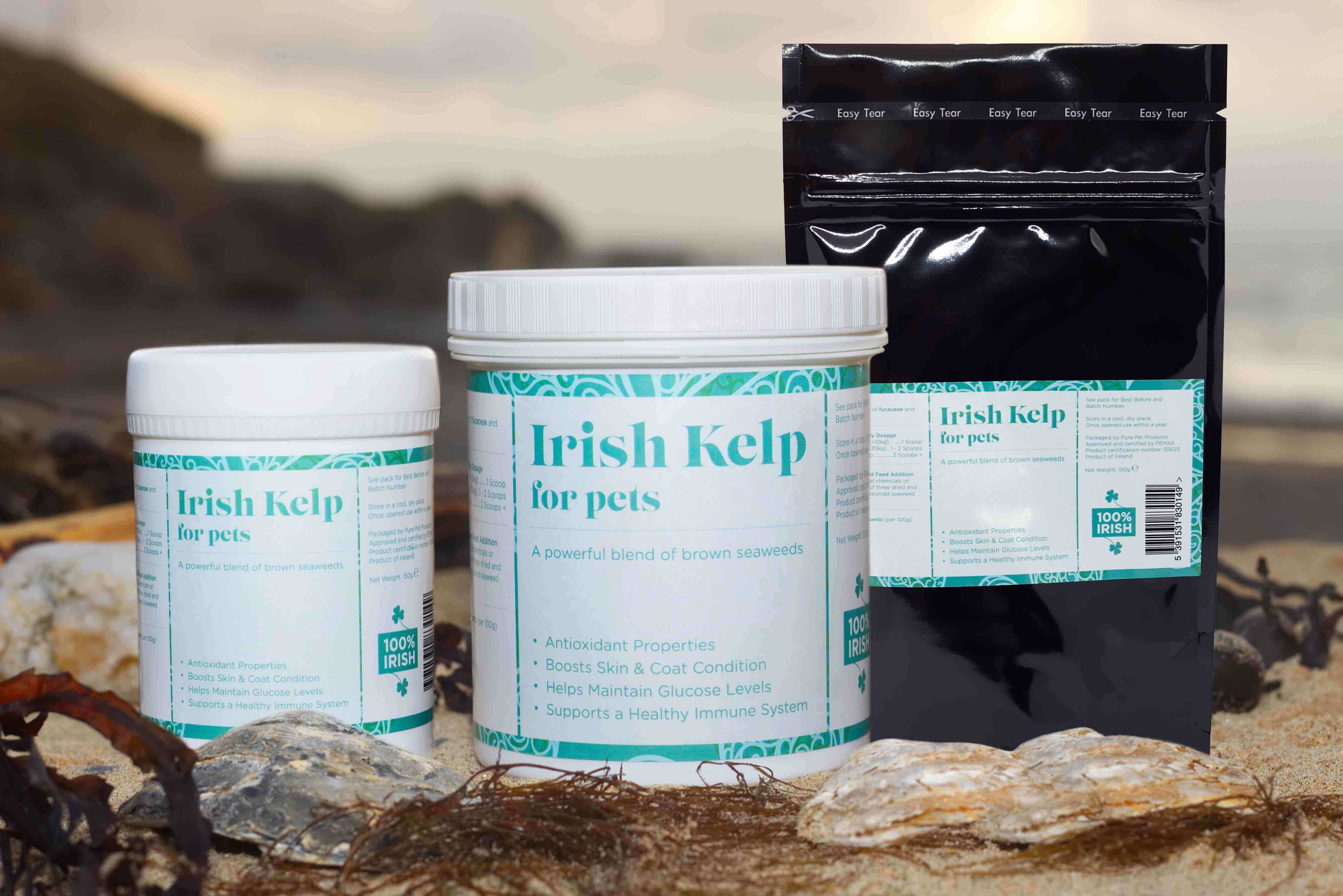
And these are just the studies of whole plant ingredients. There are literally tens of thousands of studies that show things sulforaphane, isolated from cruciferous vegetables, and lycopene, isolated from tomatoes and watermelon, are effective at fighting various canine cancers (Shieh et al. 2010, Wakshlag 2010, Rizzo et al. 2016), that isolates of grape juice are effective at reducing platelet aggregation in dogs which may be useful for treatments of both dogs and humans with heart issues (Osman et al. 1998), not that you should feed grapes to dogs! Pick your amazing vegetable or fruit phytonutrient of choice, the experiment was first done on rats, then dogs and once effect is seen, tested on humans.
AND this is leaving out the tens of thousands of studies that show herbs are highly effective in the treatment of most canine maladies.
For any of the nerds out there, from vets to nurses, breeders to nutrition enthusiasts, the very best book on Veterinary Herbology is Veterinary Herbal Medicine by Wynn and Fougere. It’s an unbelievable collection of the science supporting the use of herbs in practically every maladie you’ve ever encountered. Fascinating reference manual, no shelf is complete without it. I get so many blog ideas from it! Best spent £80 of your life.
3. Fibre…
If you remove all source of fibre from the dogs diet (hair, nails, feathers, hide and other indigestible bits) then plant fibre is a highly effective way to bulk the stool with much-needed water. It’s used heavily by all pet foods, dry and raw (the latter as their mixes can be a bit boney). Prey Model folk include hair etc in their mixes and it works for them but this could alienate a lot of the market from choosing the fresh option.
But studies also show plant fibre, perhaps surprisingly for such a meat eater, is known to be an effective prebiotic in dogs. Studies show it has a range of benefits including improved gut flora, reduced diarrhoea in sled dogs and preservation of the gut cell wall when sick. I can say first hand that gluten-free sources of fibre such as StoolRite are incredibly effective at softening hard poos and hardening soft poos, believe it or not. A great source of fibre for your raw fed dog is cooked sweet potato with the skin on, it has all the good bits.

4. Some dogs might need carbs...
Unlike most dogs, sighthounds like greyhounds and lurchers have fast twitch muscles and these benefit from having some carbs in the diet such as oats (boiled or soaked overnight) or sweet-potatoes in their diet. 10-20% is what many are doing. OK, they don’t need them, but they certainly seem to benefit. I also use some carbs on some dogs that are struggling to put on much-needed weight and I know there’s no cancer under the hood. Puppies too, now and again. I also like to give Duds a warm brekkie on freezing mornings, shoot me! I mix some of his meat mix in with my warm porridge and give him a sticky, warm slop. He loves it.
5. Veg can be used for various ailments…
Overweight dogs are best dieted on lean diets. That’s a fact. One way would be to move them to a very lean chicken or turkey breast diet with some organ meat but if you have a big laborador that could break the bank. Another perfectly fine way to diet dogs is to feed them a lower fat diet and simply include more cooked veg (up to 30%). This means your dog still gets a nice big meal but the calorie kick is lower. The same ethos is used when treating dogs with pancreatitis, vegetables are used to reduce the pancreatic load. The higher veg content works extremely well for these conditions.
6. Cost…
The pet food market is split right down the middle, with half choosing the best food for their dog and the rest choosing what they can afford. Like it or not, the cost of raw pet food is a very real concern for half of dog owners today and feeding an all-meat and bone diet to their large carnivore is something some families cannot do, often to their distress. To avoid owners not making the change to fresh ingredients, we all need to understand that a diet of 75% fresh meat, organ and bone ingredients with perhaps 25% porridge or sweet potato as a filler is way, way, waaay better nutritionally speaking than any dry food out there including the top of the range, super premium dry foods, and that cost saving could make all the difference. Baby steps.
7. Great use of leftovers…
The idea of feeding leftovers was first criminalised by the pet food industry in the 80’s. Much like the “eggs might give you cholesterol issues” (a clever misuse of the data by breakfast cereal sector), it was simply a ploy to sell more products. But dogs evolved to hang out with us for a reason, probably beginning with our kill leftovers as well as poo left around but surely they’d be happy enough with all the little tasty, accessible bits we left around. Ripe fruit. Old bread, etc. So, giving them some of your leftovers in on top of a cracking diet is more than fine. It’s an environmentally sound way of getting rid of your leftovers too and with you owning a little meat eater, and meat being the most environmentally unfriendly food item out there, we raw feeders need to take as many environment-saving steps as possible to alleviate the possible damage done.
Plant ingredients recommended for your dog…
Most veg and fruit can be fed to dogs though some are better than others. In general, aim for the slow-to-digest kinds and avoid the rapidly-digested starch items (rice, white potatoes, cereals bar oats). Thus plant items you might include in your DIY raw dog food mixes are the following, I put a suggested inclusion range but some people use more at certain times, others choose not to use them, up to yourself!
Vegetables (0-10%)
- Leafy greens
- Green beans
- Broccoli
- Carrots & Peas
- Seaweed and herbs
Carbs (0-10%)
- Oats / porridge (boiled or soaked overnight). Sprouted oats are the most nutritious but they’re pricey and not so filling. Best to use them in your DIY Pet Herb Garden
- Couscous (a cereal that is higher in protein than the others) or better still Amaranth (looks like couscous but is actually a small, round plant, higher in protein again than couscous).
- Pumpkin / squash / sweet potatoes (boiled, skins on, that’s where the great fibre is)
Fruit (0-3%)
- Blueberries & blackberries (best)
- Pomegranate
- Melon
- Apple
Make Power Cubes…
I know lots of folk that make up “power cubes” where they grind their favourite fruit and veg, add a few cool supplements and freeze in a large ice cube tray. Pop one in each bowl each meal! You can even get large, bone-shaped ice cube trays on Amazon, just to increase the cute factor a bit!
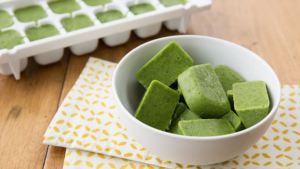
When veg goes bad in dogs…
I mean this both ways. First off, please don’t be tempted to grind up a lot of veg and keep it in a tub in the fridge. It will oxidise, turning brown, in a matter of days and while not the worst for us it will turn their stomach. Add veg fresh as you can or add it to DIY raw dog food before mixing or freeze in portions.
Also please note, don’t feed too much veg. Too much vegetable matter in dogs could have a number of side effects, including changing the gut flora beyond what might be considered normal but also it may alkalise the dog’s body (carnivores prefer things a little more acidic) which could result in kidney issues.
Too many carbohydrates are not recommended either. High-carb, cereal-based dry foods are strongly suspected to be the cause of all the pancreatitis and kidney disease we see in dry fed cats and dogs. But I have seen this occur in a raw fed dog too. Their owner was feeding him a lot of white rice (50% of his diet), some fatty beef mince and some veg. This is not ideal at all. Tt would be a lot of pressure on the pancreas and eventually caught up with him.
There is some concern knocking around about cruciferous vegetables (broccoli, cauliflower, sprouts) and some leafy greens, particularly for dogs with hypothyroidism. The concern is for their goitrogenic properties, a substance that may cause the thyroid gland to enlarge (like the disease goitre). This may impede they thyroid’s ability to function properly. For years, the advice for owners of possibly thyroid-sick dogs was to avoid them. However, much like the garlic concern, Dr. Jean Dodds assures us the goitrogenic properties of these veg are so minute the benefits (from antioxidants and vitamin K) of feeding these veg greatly outweigh all concerns, so they should be fine in moderation for most dogs.
There is also some concern following a recent study that found beet pulp (or at least the indigestible fibres added to dry dog food) may be at fault for a taurine (an amino acid) deficiency which can lead to DCM (Dilated Cardio Myopathy) in dogs. However, the findings were inconclusive. It’s also worth noting the researchers in the study were using lamb and rice dry food which seems to have more side effects to it than most foods. These foods have the minimum amount of protein for your dog. Because it’s so expensive they leave your dog desperately short of it. Hence if any little thing upsets the balance of it (in this case beet pulp is thought to affect the bile acids, reducing its presence in the intestines which means even less protein might be digested) then yes it could possibly be a vector. Luckily, if you’re on here you know cereal-based dry food is absolutely not recommended and you are probably feeding the dog like the meat-eater he is. This means a diet that is naturally very high in taurine. So don’t worry, he won’t be going short.
And finally, watch your fruit sugar. I don’t use too much fruit bar the odd few blueberries. Too much fruit sugar can cause them problems, not least of all yeast issues in dogs. If your dog has a recurring itch then removing all fruit (and carbs as a whole) is one thing to try to check if it’s yeast related (yeast needs sugar to live, some us are more sensitive than others, certainly dogs after antibiotics).
Feeding dogs vegetables, in conclusion…
Do dogs need plant ingredients to survive? No, they don’t. Might they benefit from some vegetable matter added to their diet? Absolutely 100%.
***
I have spent a lot of time building up my knowledge. From a doctorate in animal behaviour and nutrition to years in guide dogs and the last seven year inside and out of the pet food industry, I have always provided all my information free to the public, articles that I spend a lot of time putting together. While it’s clearly a passion of mine the fact remains, I can’t do this and a steady job at the same time. Without a salary or fancy sponsorship, I am left trying to monetise my site as much as I can without pushing on you horrible adverts for car loans and crap pet products. One way I do this is by tracking some of the links to products I rarely but absolutely recommend found on Amazon (as an Amazon Associate I earn from qualifying those purchases). Another is popping a few ads for my supplements in some of my articles. finally, I’m now going to put a donation button at the bottom of my longer articles. So, if this helped you in any way and you feel you’d like to give me the price of a cup of coffee (€3), please free to do exactly that. If you’re strapped and can’t afford it, I can totally sympathise, you’re free to read on, no questions asked. We’re glad to have you on board spreading the word regardless.
Many thanks and continued good health to you and your pets.



